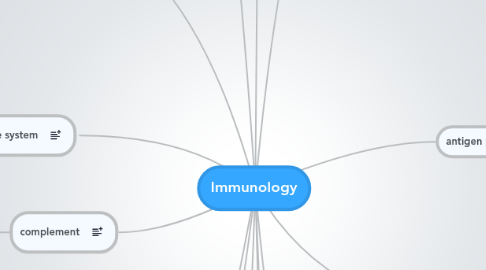
1. PRR
1.1. Toll like Receptors
1.1.1. Surface TLRs
1.1.1.1. TLR 1
1.1.1.2. TLR 2
1.1.1.3. TLR 4
1.1.1.4. TLR 5
1.1.1.5. TLR 6
1.1.2. Intracellular TLRs
1.1.2.1. TLR 3
1.1.2.2. TLR 7
1.1.2.3. TLR 8
1.1.2.4. TLR 9
1.2. C-type Lectin
1.3. NOD Like Receptor
1.4. RIG-like receptors
2. Innate
2.1. Cellular
2.1.1. Granulocyte
2.1.1.1. Neutrophils
2.1.1.2. Basophils
2.1.1.3. Eosinophils
2.1.1.3.1. histamine & leukotriene
2.1.1.4. Mast cells
2.1.2. Monocytes
2.1.2.1. Macrophage
2.1.2.2. Dendritic
2.1.3. innate-like lymphocytes
2.1.3.1. Natural Killer NK cells
2.1.3.1.1. perforin
2.1.3.2. B-1 cells
2.1.3.3. epithelial gamma:delta cells
2.1.3.4. NK T cells
2.2. Non- Cellular
2.2.1. Lysozyme
2.2.2. defensins
2.2.3. Transferrin
2.2.4. opsinisaton and complement activating proteins
2.2.4.1. Pentraxins
2.2.4.2. Collectins
2.2.4.3. Ficollins
2.2.4.4. Complement
2.2.4.5. Natural Antibodies
3. complement
3.1. Classical Pathway
3.1.1. Antibodies + Complement
3.2. Alternative Pathway
3.2.1. Microbe surface element + complement
3.3. Lectin Pathway
3.3.1. Mannose binding lectin + complement
4. Pathogens
4.1. Parasites
4.1.1. Trypanosomai Brucei
4.1.2. Schitosomiasis spp.
4.2. fungal infection
4.2.1. Aspergillus Fumigatus
4.2.2. Cryptococcus neoformans
4.2.3. Candida Albicans
4.2.4. Immune responses against fungal infections
4.3. Viruses
4.3.1. Innate immune response
4.3.1.1. IFN type I
4.3.1.2. NK cells
4.3.2. Adaptive immune response
4.3.2.1. Antibodies
4.3.2.2. Cytotoxic T cells
4.3.3. Retroviruses
4.3.3.1. Human T lymphotropic VIrus (HTLV) 1
4.3.3.2. Human Immunodeficiency Virus (HIV)
5. Disorders
5.1. Hypersensitivity
5.1.1. Type I: IgE mediated
5.1.1.1. Anaphylaxis
5.1.1.2. Allergy
5.1.1.3. Atopy
5.1.1.4. Allergic Asthma
5.1.2. Type II: IgM and IgG mediated
5.1.3. Type III: immune complex mediated
5.1.4. type IV: T cell mediated
5.1.4.1. multiple sclerosis
5.1.4.2. type I diabetes
5.1.4.3. contact sensitivity
5.2. Cancer
5.2.1. Tumour Antigens
5.2.2. Vaccines against oncogenic DNA Viruses
5.2.3. Immune responses against cancer
5.2.3.1. NK cells
5.2.3.2. Macrophages
5.2.3.3. CD8+ T cells
5.3. Autoimmunity
6. Medical Approach
6.1. vaccines
6.1.1. Features
6.1.2. Example: peptide vaccines
6.1.3. Adjuvants
6.1.4. Example: Hep B
6.2. Transplant
6.2.1. Tissue matching
6.2.2. Immunosuppression
6.2.2.1. Azathioprine
6.2.2.2. Corticosteriods
6.2.2.3. Cyclosporin-A
6.2.2.4. Sirolimus
7. Evolution of the Immune system
7.1. Deutrostromes
7.1.1. Jawless vertebrates
7.1.1.1. Innate and acquired immunity
7.1.2. Jawed vertebrates
7.1.2.1. Innate and novel acquired immunity
7.2. Protosomes
7.2.1. Innate immunity
8. Adaptive
8.1. B cells
8.1.1. B cell receptor
8.1.1.1. Co receptors
8.1.1.1.1. Ig alpha
8.1.1.1.2. Ig beta
8.1.2. B-cell development
8.1.2.1. Bone marrow
8.1.2.1.1. Ig gene rearrangement - V(D)J recombination
8.1.3. Antibody production
8.1.3.1. IgM
8.1.3.2. IgG
8.1.3.3. IgA
8.1.3.4. IgE
8.2. T cells
8.2.1. T cell development
8.2.1.1. 1. Bonemarrow
8.2.1.2. 2. Thymus
8.2.1.3. 3. Activation and proliferation in peripheral tissues
8.2.1.3.1. CD4+ Th cells
8.2.2. T cell subsets
8.2.2.1. Treg
8.2.2.1.1. Natural FOXP3+ Treg
8.2.2.1.2. Inducible iTreg
8.2.2.2. CD4+
8.2.2.2.1. TH17
8.2.2.2.2. TH1
8.2.2.2.3. TH2
8.2.2.2.4. T(FH)
8.2.2.3. CD8+
8.2.2.3.1. Cytotoxic T cells
8.2.2.4. gamma delta T cells
8.2.3. T cell receptor
8.2.3.1. Co receptors
8.2.3.1.1. CD3
8.2.3.1.2. Zeta
9. signalling
9.1. cytokines
9.1.1. anti-inflammatory
9.1.1.1. IL-10
9.1.1.2. TGF beta
9.1.1.3. IL-2
9.1.2. inflammatory
9.1.2.1. TNF
9.1.2.1.1. targets
9.1.2.2. IL 1
9.1.2.3. IL 6
9.1.2.3.1. targets
9.1.2.4. IL 12
9.1.2.5. IFN Gamma
9.1.2.6. IL 8
9.1.2.7. IL-15
9.1.2.8. IFN type 1
9.2. Chemokines
9.2.1. Lymph node localisation
9.2.1.1. CCL19 & CCL21
9.2.1.2. CXCL5
9.2.2. recruitment into the infection site
9.2.2.1. CCL2
9.2.2.2. CCL11
9.2.2.3. CXCL8
9.2.2.4. CCL5
9.2.2.5. CCL3
9.2.3. homing of naive T and B cells
9.3. Lipid mediators
9.3.1. inflammatory
9.3.1.1. Prostaglandins (PGI2)
9.3.1.2. Leukotrienes
9.3.1.3. Platelet activating factor
9.3.2. Anti-inflammatory
9.3.2.1. Glucocorticoids
9.3.2.1.1. Cortisol
9.4. Vasoactive amines
9.4.1. Histamine
9.5. co stimulation
9.5.1. B cell to T cell
9.5.1.1. CD40
9.5.2. Antigen presenting cell to T cell
9.5.2.1. Inhibitory
9.5.2.1.1. CTLR4
9.5.2.2. Activating
9.5.2.2.1. CD28
9.6. Intracellular signalling
9.6.1. initiation
9.6.2. general principles
9.6.2.1. 1) Receptor Activation
9.6.2.2. 2) Tyrosine Kinase (TK) Activation
9.6.2.2.1. TK Structure
9.6.2.3. 3) Transcription factors
9.6.3. BCR, TCR and TLR
9.6.3.1. TCR complex
9.6.3.1.1. Mechanism
9.6.3.2. BCR complex
9.6.3.2.1. Mechanism
9.6.3.3. regulation of TCR / BCR signaling
9.6.3.4. TLR Mechanism
10. antigen presentation
10.1. MHC
10.1.1. MHC class I
10.1.1.1. Production
10.1.2. MHC class II
10.1.2.1. production
11. localisation
11.1. Adhesion
11.1.1. integrin
11.1.1.1. LFA-1
11.1.1.1.1. Also help cell to cell adhesion for MHC sampling
11.1.2. selectin
11.1.2.1. E-selectin
11.1.2.2. P-selectin
11.1.2.3. L-selectin
12. Fc receptor
12.1. B cells
12.2. Phagocytes
12.3. Mast cells
12.4. Triggering
12.4.1. High affinity
12.4.2. Low affinity
12.5. On complement
12.6. Allow recycling of antibodies
13. immune tissue
13.1. Primary
13.1.1. Bone Marrow
13.1.2. fetal liver
13.1.3. Thymus
13.2. Seconday
13.2.1. Lymph nodes
13.2.2. Spleen
13.2.3. Peyers patch
13.2.4. Peripheral tissue
13.2.5. mucosal immune tissues
14. Cell type associated cytokines
14.1. T-cells
14.1.1. CD4+
14.1.1.1. Th1
14.1.1.1.1. IFN gamma
14.1.1.2. Th2
14.1.1.2.1. IL-4
14.1.1.2.2. IL-13
14.1.1.2.3. IL-5
14.1.1.3. Th17
14.1.1.3.1. IL-17
14.1.1.3.2. IL-22
14.1.1.4. Treg
14.1.1.4.1. IL-10
14.1.1.4.2. TGFbeta
14.1.2. CD8+
14.1.2.1. IL-2
14.2. B Cells
14.3. Innate
14.3.1. Dendrite and macrophage
14.3.1.1. IL-12
14.4. NK cells
14.4.1. IFN gamma
